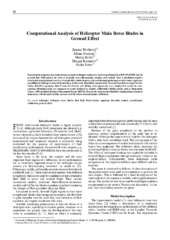Приказ основних података о документу
Numerička analiza lopatica glavnog rotora helikoptera u blizini zemlje
Čislennyj analiz lopastej nesuščego vinta rotora vertoleta vblizi zemli / (francuski) Analyse numériques des aubes du rotor principal d'hélicoptère à proximité du sol
| dc.creator | Trivković, Zorana | |
| dc.creator | Svorcan, Jelena | |
| dc.creator | Baltić, Marija | |
| dc.creator | Komarov, Dragan | |
| dc.creator | Fotev, Vasko | |
| dc.date.accessioned | 2022-09-19T17:50:35Z | |
| dc.date.available | 2022-09-19T17:50:35Z | |
| dc.date.issued | 2016 | |
| dc.identifier.issn | 1820-0206 | |
| dc.identifier.uri | https://machinery.mas.bg.ac.rs/handle/123456789/2277 | |
| dc.description.abstract | Numerička analiza izolovanog, reprezentativnog glavnog rotora helikoptera izvršena je u komercijalnom softverskom paketu ANSYS FLUENT 16.2. Generalno, strujna slika oko rotora je nestacionarna, trodimenzionalna, složena i vrtložna. Takve simulacije zahtevaju značajne proračunske resurse. Uticaj zemlje, koji poboljšava aerodinamičke performanse rotora, predstavlja dodatni izazov pri numeričkom modeliranju. U ovom radu strujno polje je izračunato Navije-Stoksovim jednačinama osrednjenim Rejnoldsovom statistikom (RANS). Rotaciono kretanje uzeto je u obzir primenom dva različita pristupa: 'Frame of reference' i 'Sliding mesh'. Izvršeno je poređenje dobijenih rezultata sa vrednostima jednostavnijih modela kao što su model zasnovan na zakonima održanja (MT) i kombinovani model segmenta lopatice (BEMT). Rezultati su predstavljenu u obliku kontura pritiska, brzine i vrtložnosti kao i vrednostima aerodinamičkih koeficijenata.. | sr |
| dc.description.abstract | Numerical investigation of an isolated representative helicopter main rotor has been performed in ANSYS FLUENT 16.2. In general, flow field around the rotor is unsteady, three-dimensional, complex and vortical. Such a simulation requires substantial computational resources. Ground effect, which improves the aerodynamic performances of the rotor, represents an additional challenge to numerical modeling. In this study, flow field is computed by Unsteady Reynolds Averaged Navier- Stokes (URANS) equations. Both Frame of reference and Sliding mesh approaches were employed to model the rotor rotation. Obtained results are compared to results obtained by simpler, sufficiently reliable models such as Momentum Theory (MT) and Blade Element Momentum Theory (BEMT). Presented results include fluid flow visualizations in the form of pressure, velocity and vorticity contours and the values of aerodynamic coefficients. | en |
| dc.publisher | Beograd : Vojnotehnički institut | |
| dc.relation | info:eu-repo/grantAgreement/MESTD/Technological Development (TD or TR)/35035/RS// | |
| dc.rights | openAccess | |
| dc.rights.uri | https://creativecommons.org/licenses/by/4.0/ | |
| dc.source | Scientific Technical Review | |
| dc.subject | uticaj zemlje | sr |
| dc.subject | strujno polje | sr |
| dc.subject | rotor helikoptera | sr |
| dc.subject | Rejnoldsov broj | sr |
| dc.subject | Navije-Stoksove jednačine | sr |
| dc.subject | lopatice | sr |
| dc.subject | helikopter | sr |
| dc.subject | aerodinamički koeficijenti | sr |
| dc.subject | Reynolds number | en |
| dc.subject | Navier-Stokes equations | en |
| dc.subject | helicopter | en |
| dc.subject | helicopter rotor | en |
| dc.subject | ground effect | en |
| dc.subject | flow field | en |
| dc.subject | blades | en |
| dc.subject | aerodynamic coefficients | en |
| dc.title | Numerička analiza lopatica glavnog rotora helikoptera u blizini zemlje | sr |
| dc.title | Čislennyj analiz lopastej nesuščego vinta rotora vertoleta vblizi zemli / (francuski) Analyse numériques des aubes du rotor principal d'hélicoptère à proximité du sol | RUS |
| dc.title | Computational analysis of helicopter main rotor blades in ground effect | en |
| dc.type | article | |
| dc.rights.license | BY | |
| dc.citation.epage | 58 | |
| dc.citation.issue | 4 | |
| dc.citation.other | 66(4): 52-58 | |
| dc.citation.rank | M51 | |
| dc.citation.spage | 52 | |
| dc.citation.volume | 66 | |
| dc.identifier.doi | 10.5937/STR1604052T | |
| dc.identifier.fulltext | http://machinery.mas.bg.ac.rs/bitstream/id/1031/2274.pdf | |
| dc.type.version | publishedVersion |


